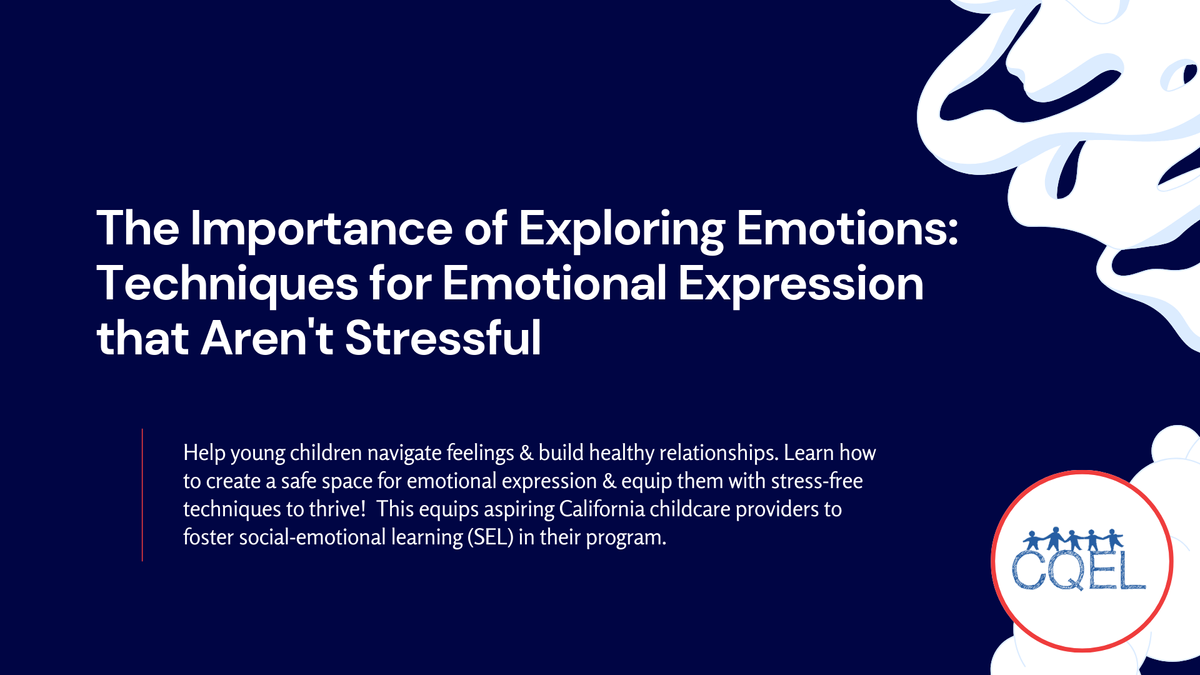The Importance of Exploring Emotions: Techniques for Emotional Expression that Aren't Stressful
Help young children navigate feelings & build healthy relationships. Learn how to create a safe space for emotional expression & equip them with stress-free techniques to thrive! This equips aspiring California childcare providers to foster social-emotional learning (SEL) in their program.

The ability to understand and express emotions is a fundamental building block for young children. Social and emotional learning (SEL) equips children with the skills they need to navigate complex feelings, build healthy relationships, and thrive in an ever-changing world. However, expressing emotions can be a challenge for young children. Limited vocabulary, difficulty identifying their feelings, and societal expectations that discourage open expression can leave them feeling confused and frustrated. As an aspiring childcare provider in California, creating a safe and supportive environment where children feel comfortable exploring their emotions is crucial. By providing stress-free techniques for emotional expression, you can guide them on their journey towards emotional literacy and well-being.
SEL is an integral part of a child's development. Recognizing and expressing emotions helps children manage stress, regulate their behavior, and develop empathy for others. These skills are essential for building strong relationships, resolving conflicts constructively, and achieving academic success. Furthermore, emotional intelligence has a significant impact on mental health and well-being throughout life.
Imagine a child struggling to express frustration, leading to a tantrum or meltdown. This frustration often stems from an inability to identify or communicate their feelings. Societal expectations can further complicate matters. Boys might be discouraged from expressing sadness, while girls might be told to "calm down" when they're angry. These messages can leave children feeling confused and ashamed of their emotions.
The key to fostering emotional expression is creating a safe space. Let children know that all emotions are valid – it's okay to feel happy, sad, angry, or frustrated. Validate their feelings and avoid minimizing their experiences. Active listening is essential. Put down your phone, make eye contact, and use body language that conveys empathy and understanding.
Visual aids are powerful tools for emotional exploration. Emotion charts with pictures of faces expressing different emotions can help children identify how they're feeling. Age-appropriate books and stories that explore different emotions can also be helpful. Movement activities offer another avenue for emotional expression. Dancing, yoga poses, or acting out different emotions allow children to express themselves physically.
Creative outlets like art, music, or dramatic play provide a safe space for non-verbal expression. Offer a variety of materials like paints, clay, or musical instruments and encourage children to explore their emotions through these creative mediums. Open-ended questions are another valuable tool. "How are you feeling?" or "What can we do to help you feel better?" These questions encourage communication and provide opportunities for problem-solving together.
California is a leader in promoting social and emotional learning in early childhood education settings. The California Department of Education's Social Emotional Learning (SEL) Framework (https://www.cde.ca.gov/sp/cd/re/) provides a comprehensive framework for integrating SEL into your curriculum. The Collaborative for Academic, Social, and Emotional Learning (CASEL) (https://casel.org/) website offers a wealth of resources, professional development opportunities, and information on social and emotional learning.
By fostering emotional expression in a safe and supportive environment, you empower young children to navigate their emotions effectively. Remember, you are not just a teacher; you are a facilitator, guiding them on a journey of self-discovery. Embrace the full spectrum of emotions, provide stress-free techniques for expression, and watch your classroom blossom into a space of understanding, empathy, and emotional well-being. After all, happy, healthy children are ready learners, and that's the foundation for a successful educational journey.
